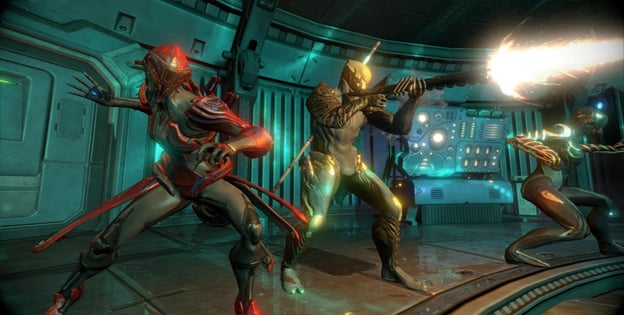The True (Free) Path
Credit card in hand, I’m eying the monitor, cursor hovering over one of the Founder packages. In my decades as a gamer, I’ve never yet put real money into a free-to-play game, viewing them as nigh-on throwaway experiences, playable only until the grind overpowers whatever fun I was actually having. It happened fairly early on with Hawken , which took a compelling concept and butchered it by sticking what little variety and novelty it possessed behind a blatant and ineffectual paywall.
But I’m looking at Warframe and thinking, “Damn, man. I could use some Platinum.”
There are frames I want to buy, new guns and melee weapons with which I want to experiment, alongside classics such as experience and income boosters, health packs and revival tools. I’m looking at pouring 50 dollars into a title that isn’t even out yet (still in closed beta) because I want to experience its depths.

But, on the surface, Warframe isn’t anything special. It’s a third-person shooter (notably: not a cover-based one) from the studio behind the eminently forgettable Dark Sector (also: The Darkness II and the upcoming Star Trek game). If that name doesn’t ring a bell, that isn’t too surprising. Dark Sector was an early Xbox 360/PlayStation 3 generation title that attempted to capitalize on the sudden popularity of Gears of War-style cover-based shooting mechanics. It involved a virus and Eastern Europe in ways that were never especially clear (nor particularly interesting), but its initial trailer had indicated that Dark Sector would be a sci-fi title with stealth elements. That’s where Warframe comes in.
Whereas Dark Sector was forgettable and sluggish, Warframe is slick and compelling, with fast-paced, white-knuckle combat. You’ll have to fluidly switch between ranged and melee weapons, carefully manage energy-demanding special abilities, and avail yourself of your ninja-esque movement capabilities to evade and slaughter enemy forces. The controls make this pretty intuitive, and have some neat, hidden combinations that infuse some much-appreciated finesse into the action, which would otherwise be fairly mundane.
It’s a unique tack, though. Warframe is a co-operative product, though you can play its missions solo if you so desire. The specific levels are randomized, but the overall thrust of any given mission remains constant, whether it involves defending a location or slaughtering every enemy on a ship. These missions are carried out against fairly predictable enemy A.I., but most enemy forces seem to make up for it in numbers.

Completing a mission rewards you (and your hypothetical partner) with experience for your weapons and frame, all of which level up independently. Frames possess a “long gun” slot and a “pistol” slot in addition to a melee weapon, though all three can be switched out between missions. Each level gained rewards you with a point to spend in the relevant weapon or frame’s skill tree. These can increase damage, health, or shields, reduce reload time, introduce or power up frame abilities, and open up mod slots, into which collected or fabricated mods can be slotted at a nominal credit cost.

More expensive are the additional weapons and blueprints for weapons (there’s a crafting mechanic in play as well, which normally demands a blueprint, time, credits, and materials obtained through missions), as well as blueprints for additional frames. Frames cannot be purchased outright for the standard credits, though, and must instead be bought with platinum, the game’s premium, real-money currency.
Platinum does sneak its way in, but as with buying frames instead of expensive blueprints, it’s more an expedient than the key to untold treasures. It can be used to complete crafting ahead of time, purchase various items from the store (including frame and weapon boosters, which unlock new upgrade paths on a piece of equipment’s skill tree), and refill one’s stock of revives. The stock of revives determines how many times during a mission one can be killed and still come back. With a default of four, each revival depletes the stock, though more can be purchased immediately for a small sum of platinum. The stock will also refill if the player simply waits until the next day.

The game itself is also constantly in flux, with new frames and weapons being rolled out by the devs, even new maneuvers (zip-lining and wall-running were recently patched in). More importantly, they’ve been learning their lesson about variety. Whereas missions used to take place all in the same basic map tilesets, regardless of the enemy force one encountered, the tilesets have since been expanded. Now missions can take place in claustrophobic hallways or sprawling mining complexes. Some missions actually seem more geared toward stealth than others, which is great to see as it mixes up the gameplay.
And thus my hand hovers over the numpad, ready to punch in the numbers on my card, to pay for a game still seeking to find itself, simply because it provides lightning-fast, visceral thrills. That the basic game, a sprawling endeavor, is entirely free seems almost impossible, but it’s clearly a testament to the distance free-to-play has come as a viable business model for even titles with high production values.
Like co-op shooters? Try this game. You won’t regret it.
Game Features:
